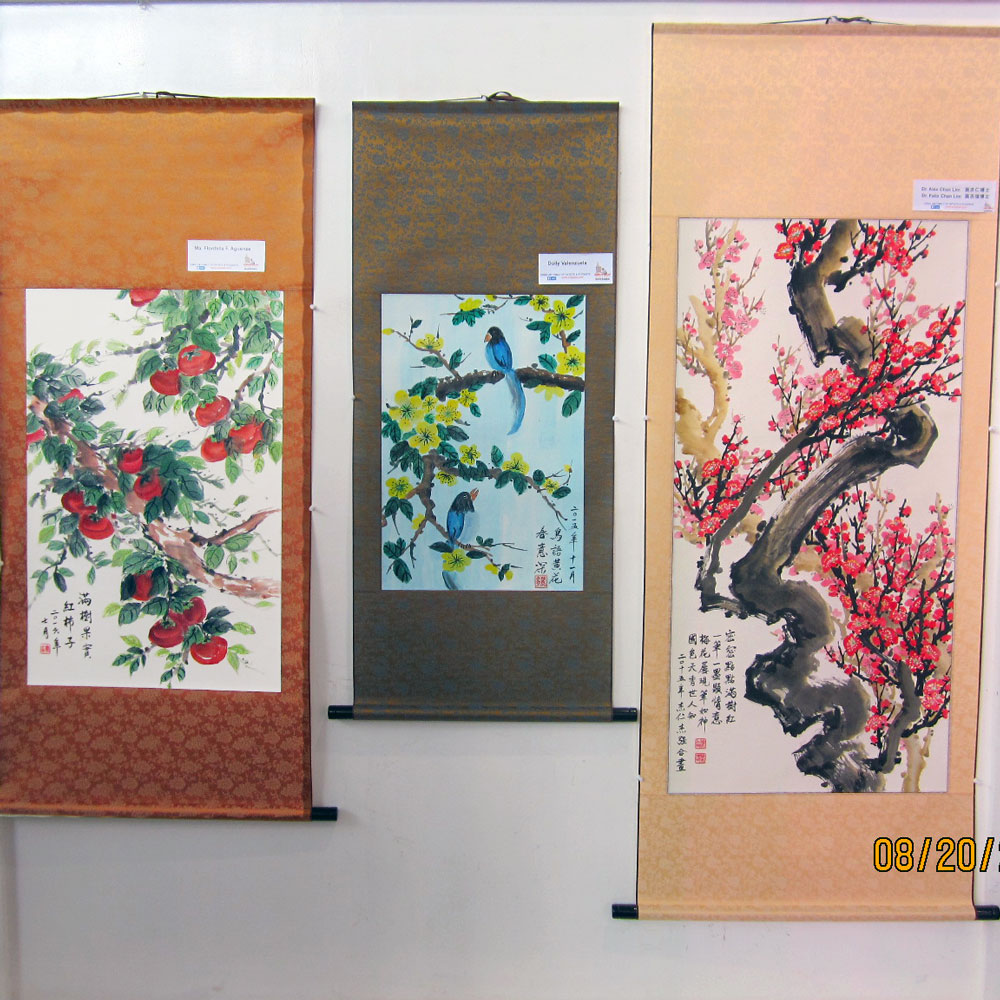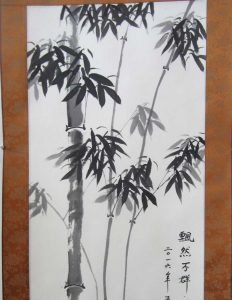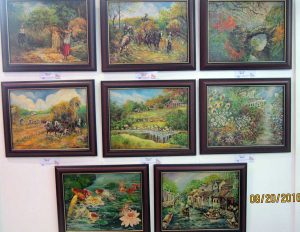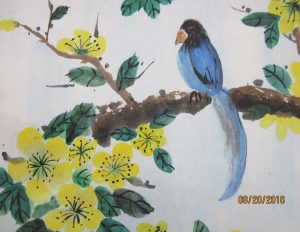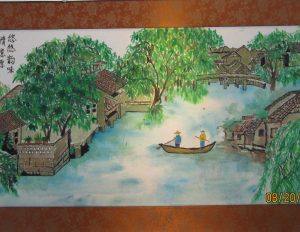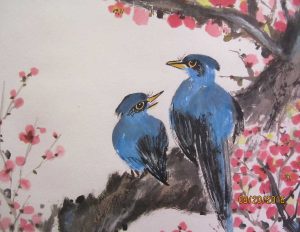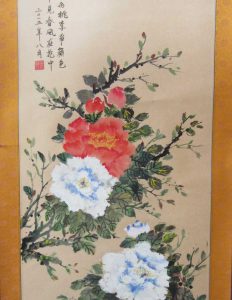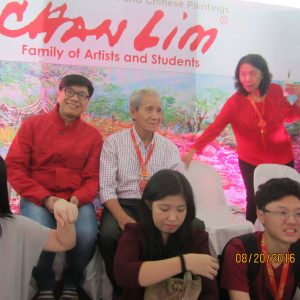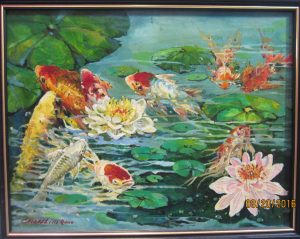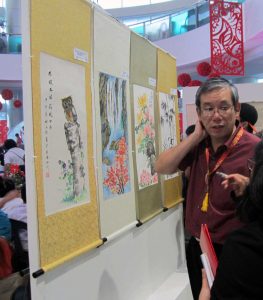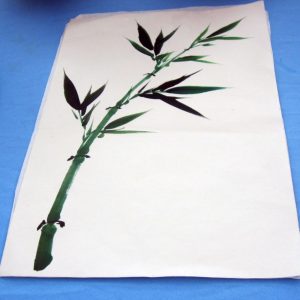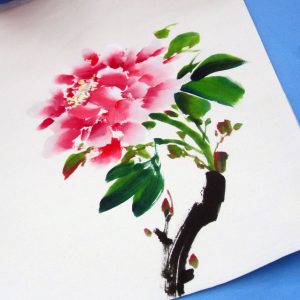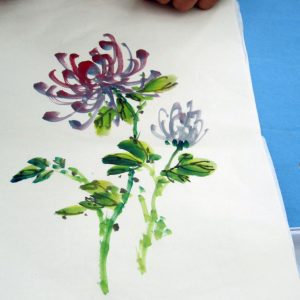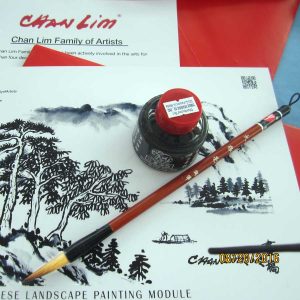I’ve always felt drawn to Chinese Paintings. I particularly liked those done in black ink; I thought they were so beautiful in their simplicity. But it wasn’t until after I met the Chan Lim Family of Artists did I truly appreciate how decidedly complex a seemingly simple Chinese painting could be. My conversations with the members of the Chan Lim family were truly enlightening. I learned so much, and I now have a better appreciation for Chinese paintings.
The Chan Lim Family of Artists’ Exhibit of Western and Chinese Paintings
My journey into the world of Chinese Painting began last August 20, Friday, when we at Naga City Guide were invited to the opening and launch of the Chan Lim Family of Artists’ Exhibit of Western and Chinese Paintings at SM Naga.
About the Event
The Chan Lim Family of Artists’ exhibit will be at SM Naga’s Event Center until September 5, 2016. There are more than a hundred Chinese paintings (mounted on scrolls) on display. There are also Western paintings from “the” Chan Lim himself.
The members of the Chan Lim Family and their students made these paintings.
The Launch
Opening day was attended by three generations of the Chan Lim family- the father, 3 sons, and 3 grandchildren. Also present were Chan Lim Chinese painting students.
The day started with Lunch, followed by a Press Conference, a Chinese Painting Workshop for members of the media, then the formal opening of the exhibit. After the opening (read: Ribbon Cutting), students from St. Joseph School and Naga Hope Christian School were also treated to a Chinese Painting Workshop.
But I am getting ahead of myself.
Meeting the Chan Lim Family
I and company arrived early at the SM Naga Atrium. While we were waiting for the Press Conference to start, I passed the time by reading the materials given to the press.
From it, I learned that there are now three generations of Chan Lim artists. The patriarch – the first generation in the Chan Lim Family of artists – specializes in Western painting.
He has four sons (in order from the oldest to the youngest): Alex, Felix, Rolex, and Jolex. All of them are engineers. All of them are working for multinational companies. But even more strikingly, every one of these second-generation Chan Lims are Chinese Painting artists.
And I learned later on, after one of the several conversations I had with Chan Lim family members, that all five Chan Lim grandchildren also paint.
[There are actually six grandkids, but the youngest is only 9 months old, so he isn’t quite physically up to the task just yet – although I wager the baby has already held a Chinese brush and doodled some on rice paper.]
But there was so much more to the Chan Lim Family of Artists than what was on that brief press release. And boy was I glad I spent a lot of time chatting up the Chan Lims.
Jose Lim a.k.a. “The Chan Lim”
Mr. Jose Lim is “the” Chan Lim. Nearly eighty, he is the patriarch – the first generation – of the Chan Lim Family of Artists. The name “Chan Lim” is what he uses to sign his paintings. It is the combination of his and his wife’s last names.
I was lucky enough to have a moment’s chat with “Chan Lim” himself. I knew from the press briefing that he specializes in Western paintings. So I asked him for details about his art.
He told me that he fuses Chinese and Western art in his paintings. For instance, he uses the Chinese brush while painting oil on canvas. It’s not only the Chinese brush he incorporates into his Western style painting; he also uses the brush the way it’s used in Chinese paintings. The result? Western paintings with a decidedly Oriental feel.
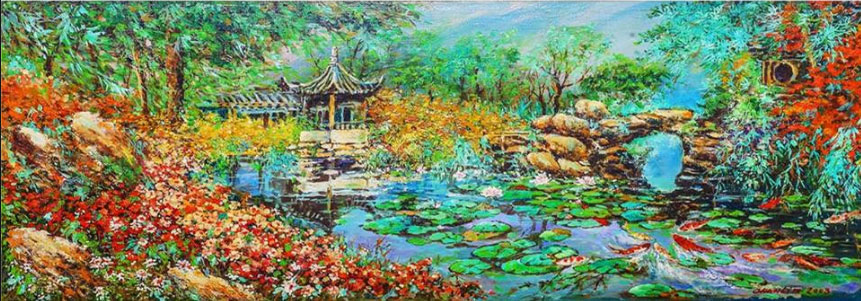
Chan Lim’s Oil Painting; the representative art of the Chan Lim Family of Artist’s Exhibit in SM Naga. The painting itself was not at the exhibit; it remains at the family home.
At the exhibit, I looked with fresh eyes at Chan Lim’s oil paintings. Indeed, the medium is decidedly oil, but it did have some Chinese flavor. Eng’r Felix Chan Lim later added that while the Chinese brush was used and used the Chinese way – with precise wrist control – the technique is decidedly Western, pointing out the overlapping technique used as a case in point.
The “Chan Lim” Siblings
During lunch, we were lucky enough to be seated with eldest sibling, Eng’r Alex Chan Lim. Also at the table was DWNX’s Ms. Grace Inocentes.
I’m afraid Eng’r Alex wasn’t able to enjoy his lunch as much because it was like a mini-press conference at our table. I had a lot to ask him, so I asked a looot of questions. Fortunately, he obliged. So I learned that (as the brief included in the press kit says), there are four Chan Lim siblings, all of them engineers: Alex, Felix, Rolex, and Jolex. All the siblings except Rolex were present.
All the second-generation Chan Lim artists have full-time jobs and paint for fun. In fact, Eng’r Alex works for Moneygram. Eng’r Felix is based in San Francisco, works at Silicon Valley, and teaches Chinese painting, part-time, at Stanford University. He’s back in the Philippines for the first time this year, and would be flying back to the US soon after the launch of their exhibit in Naga.
A Chat with Eng’r Felix Chan Lim
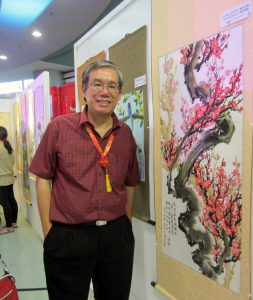
Eng’r Felix Chan Lim poses beside the painting of a plum tree. It’s a painting he and brother Alex made. Felix painted the trunk, Alex painted the flowers and the calligraphy.
After the press conference and a demo by Eng’r Felix Chan Lim, the members of the local media tried their hands on Chinese painting. I had the rare privilege to have Eng’r Felix himself as my Chinese painting 101 teacher. He told me I must first coat the brush with the base color, then layer the other colors on the brush, placing them just so to achieve the correct gradation when I put brush to paper. Needless to say, the lessons were excellent, although the student (yep, me) was more than a bit lacking.
After the media workshop, the Chan Lim family members and students and the members of the local media proceeded downstairs for the opening program and ceremonies. While waiting for the program to start, Eng’r Felix was kind enough to show me around the exhibit floor. He showed me two paintings of his, the one made by him and brother Alex, and one he made in 1994 – a painting of Chinese peony flowers.
We also got to talking about his life as an art teacher in San Francisco. He said his students typically take his classes to learn precise brush control – something so inherent to Chinese painting. I also learned that his wife, Dr. Bobbi co-teaches that Chinese painting course with him. He then showed me his wife’s painting of an owl and a painting of strawberries by his daughter, Yona.
While discussing his father’s painting, he revealed that, like his father, he likes using the Chinese brush on his Western-style watercolors. However – unlike his father who holds and uses the Chinese brush (when painting oil on canvas) the way it’s used in Chinese paintings – Eng’r Felix holds and uses the Chinese brush the Western way.
In the Beginning
Chinese painting, Eng’r Alex said, is a passion that all the siblings share. Since “the” Chan Lim – that is, the siblings’ father – mostly worked on Western paintings, I was curious why all four Chan Lim siblings seem to be focused mainly on Chinese paintings instead of Western paintings.
Chan Lim, the father, provided the answer. He told me his wife insisted that their children practice the art of Chinese painting.
Eng’r Alex confirmed this during the press conference. Apparently, the summer when he was 11 and his brother Felix was 9, the siblings had to spend every day working on improving their Chinese brush painting skills. At the end of the day, their mom would go around inspecting and reviewing their paintings. He jokingly remarked,
Our mother did not paint, but she was really good at giving us insightful critique.
Thus their passion for Chinese painting started that long-ago summer and persists to this day. At present, they spend a lot of their time at their family studio.
A Legacy

A third generation Chan Lim (with camera, center) fully immersed in the family’s artistic tradition and activities
The third generation of Chan Lims, specifically Eng’r Alex’s three children (one son, two daughters), also spend a lot of their time painting at the family studio in Pasig. All his children are involved in the Chan Lim enterprise in one capacity or another. Eng’r Felix also told me that his two daughters in the U.S. similarly enjoy the art of Chinese painting.
Knowing that the second-generation family members are all employed full time in the corporate world, I had to ask. What if, unlike the second generation of Chan Lims, members of the third generation decide they want to pursue Chinese painting as a full-time vocation – would they be allowed to do so? Eng’r Alex replied,
We will not dictate to our children, so that would be okay. The children are free to do what they want to do with their life.
Aside from painting regularly, the Chan Lim family also spends a lot of time showing in various parts of the country, conducting Chinese painting workshops, and even teaches Chinese painting in their studio. When asked why they do this, Eng’r Felix answered,
We do this to promote and teach the art of Chinese painting, and we love it when students show interest in it.
Eng’r Alex added,
We consider it part of our family’s Corporate Social Responsibility. It’s our way of giving back to the community. And when we go around, it’s rewarding to see more and more people getting interested in Chinese painting.
A Matter of Brush and Stroke
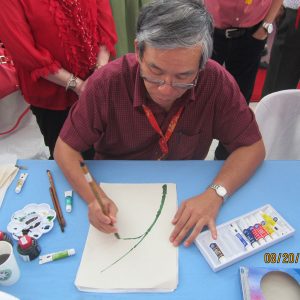 During the Chinese painting demo led by Eng’r Felix Chan Lim for members of the local media, I got up close and personal to the art of Chinese painting.
During the Chinese painting demo led by Eng’r Felix Chan Lim for members of the local media, I got up close and personal to the art of Chinese painting.
The materials: Rice Paper, Chinese brush, black Chinese ink, regular water color, water in a cup for thinning paint and softening the brush.
[By the way, the paintings mounted on scrolls at the exhibit are also on rice paper – albeit thicker than the rice paper we practiced on; Eng’r Felix told me later that Chinese paintings are typically mounted on scrolls to prevent wrinkling, to which rice paper is particularly prone.]
First, Eng’r Felix demonstrated how to draw the quintessential Chinese painting subject: the Chinese Bamboo. Later in the day, I learned from a Chan Lim student, Ms. Flor Pan (retired, has been painting for 4 months, and showing 2 of her paintings at the exhibit), that the Chinese Bamboo is one of the most difficult subjects to paint in Chinese painting. Next, he drew a Chinese peony. Lastly, he painted a Chrysanthemum.
I was lucky enough to be directly facing the master as he demonstrated Chinese painting. As a result, I got to learn a lot about the art, particularly what differentiates it from its Western counterpart.
It’s How you Layer Paint on the Brush
The first lesson I learned is that, in Chinese painting, applying paint to brush is crucial to the process. The way the artist layers the paint on his brush will determine how the colors would appear on paper. Thus, gradation of colors on Chinese paintings – say, the blackish/dark green to green gradation on Chinese bamboo leaves – is achieved by applying the colors separately and strategically on the brush.
Putting Brush to Paper
Depending on where the artist wants gradation of colors (at the center of the stroke or at the edge of it), he’ll have to move his brush just so to achieve his desired effect. It’s difficult to explain. Suffice it to say that if you want the color on the tip of the brush to be at the edge, then the stroke and the direction of the brush as you commit it to paper will have to conform to that end – i.e. with the tip at the outer edge and the base nearer to you. If, on the other hand, you want the deeper color at the center, then the stroke and direction of the brush will also change, typically with the base of the brush head leading the tip.
No Prelim Sketch
In Chinese painting, there’s no preliminary sketching like in Western painting. The artist paints directly on the rice paper. Thus, in Chinese paintings, it’s important that the artist has a plan in mind. He must know what he wants to paint, where to apply his paint, and how to apply his paint to his brush if he were to produce his desired work of art.
The Brush, Grip and Flick of the Wrist
You use a Chinese brush in Chinese painting. Chinese brushes vary in the the brush head sizes. The hair on the brush is important. It needs to be able to absorb sufficient amounts of water to ensure that the brush strokes would be as intended and won’t fall short of the target length.
The Chinese brush is held straight down. The artist holds it near the middle of the brush stem or handle. Then the brush’s movements are all controlled by wrist movement.
A Single Brush Stroke
I learned that in Chinese painting, you paint in single strokes. There’s no gliding over the same spot to achieve the desired intensity or concentration of paint. There’s no overlapping technique to add depth. A Chinese painting artists must be precise in his brush strokes. As a case in point, if one is painting a Chinese bamboo leaf, one has to paint that leaf from base to end in a single brush stroke.
Of course, an artist may have to paint over an element he drew earlier, but that’s just necessary for replicating the subject and is technically not overlapping or layering. As a case in point, after painting the strawberry, one has to paint black dots all around it to show the strawberry’s spots. Then of course, after painting a peony leaf, one has to paint over it to show the venation of that leaf.
Foreground First
Eng’r Felix – while we were walking around the exhibit floor – also told me that when he makes a Western painting, he has to reverse his thought process. In Chinese painting, the artist first paints the focus or the main subject of the painting (typically in the foreground) before he paints the other components (typically in the background). Say, in a peony flower painting, the artists has to make the flower first (petal by petal), and only afterwards does he add the stem, the leaves, and all the other parts that a peony flower make.
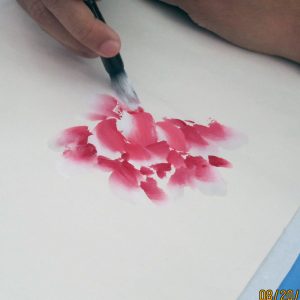
This demonstrates how the artist focuses first on the main subject of the painting – in this case, the peony flower – before adding accents and other background elements
In Western painting he says – particularly in oil paintings – the artist often starts with the background and only after finishing that does he paint the foreground. Eng’r Felix says this reversal is still related to the painting technique used. In Western paintings, the overlapping technique is used, whereas that is not the case in Chinese painting.
Control the Water
Finally, Eng’r Felix also emphasized the importance of water in Chinese paintings – specifically, the amount of water on the brush. It’s water that lets the brush glide on paper and helps deliver paint to it. The amount of water is specially crucial in paintings that require long strokes. Too much water and your painting will be flooded. Too little water and your paint will not last the full length of the required stroke.
